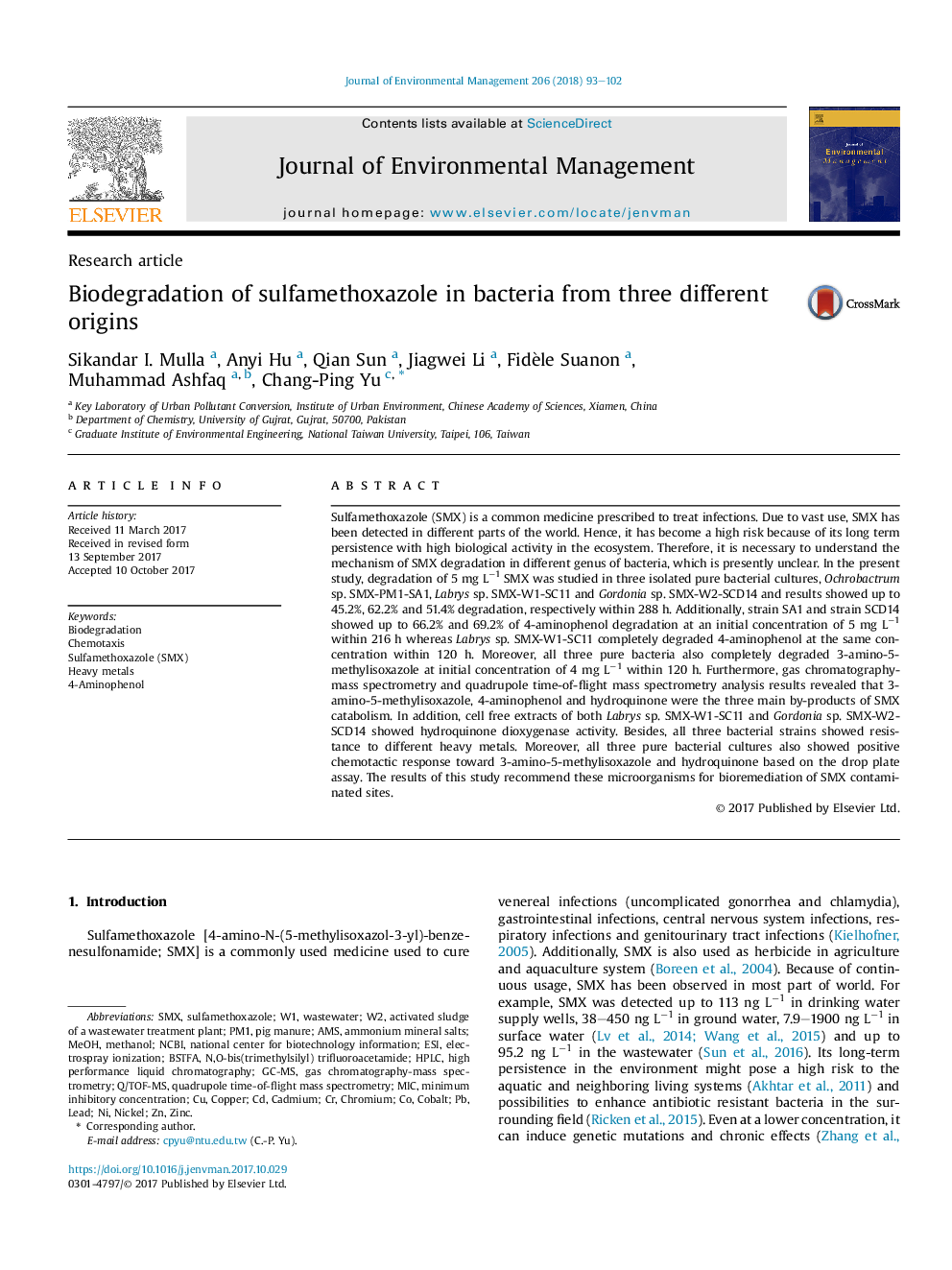| کد مقاله | کد نشریه | سال انتشار | مقاله انگلیسی | نسخه تمام متن |
|---|---|---|---|---|
| 7478613 | 1485212 | 2018 | 10 صفحه PDF | دانلود رایگان |
عنوان انگلیسی مقاله ISI
Biodegradation of sulfamethoxazole in bacteria from three different origins
ترجمه فارسی عنوان
تجزیه زیستی سولفامتوکسازول در باکتری از سه ریشه متفاوت
دانلود مقاله + سفارش ترجمه
دانلود مقاله ISI انگلیسی
رایگان برای ایرانیان
کلمات کلیدی
BSTFASMXPM1ESIAMSMICNCBISulfamethoxazole (SMX)GC-MS - کروماتوگرافی گازی-طیف سنج جرمی4-Aminophenol - 4-آمینوفنولBiodegradation - تجزیه زیستیMinimum inhibitory concentration - حداقل غلظت مهاریLead - سربSulfamethoxazole - سولفامتوکسازولQuadrupole time-of-flight mass spectrometry - طیف سنج جرمی چهار ساعته پروازWastewater - فاضلاب یا پسابZinc - فلز رویHeavy metals - فلزات سنگینMethanol - متانولNational Center for Biotechnology Information - مرکز ملی اطلاعات بیوتکنولوژیCopper - مسMeOH - مونNickel - نیکلCadmium - کادمیمCobalt - کبالتChromium - کروم، فلزی سخت و خاکستری رنگ high performance liquid chromatography - کروماتوگرافی مایع با کارایی بالاHPLC - کروماتوگرافی مایعی کاراChemotaxis - کموتاکسیPig manure - کود خوکGas Chromatography-Mass Spectrometry - گاز کروماتوگرافی-اسپکترومتری جرمیelectrospray ionization - یونیزاسیون الکترو اسپری
موضوعات مرتبط
مهندسی و علوم پایه
مهندسی انرژی
انرژی های تجدید پذیر، توسعه پایدار و محیط زیست
چکیده انگلیسی
Sulfamethoxazole (SMX) is a common medicine prescribed to treat infections. Due to vast use, SMX has been detected in different parts of the world. Hence, it has become a high risk because of its long term persistence with high biological activity in the ecosystem. Therefore, it is necessary to understand the mechanism of SMX degradation in different genus of bacteria, which is presently unclear. In the present study, degradation of 5 mg Lâ1 SMX was studied in three isolated pure bacterial cultures, Ochrobactrum sp. SMX-PM1-SA1, Labrys sp. SMX-W1-SC11 and Gordonia sp. SMX-W2-SCD14 and results showed up to 45.2%, 62.2% and 51.4% degradation, respectively within 288 h. Additionally, strain SA1 and strain SCD14 showed up to 66.2% and 69.2% of 4-aminophenol degradation at an initial concentration of 5 mg Lâ1 within 216 h whereas Labrys sp. SMX-W1-SC11 completely degraded 4-aminophenol at the same concentration within 120 h. Moreover, all three pure bacteria also completely degraded 3-amino-5-methylisoxazole at initial concentration of 4 mg Lâ1 within 120 h. Furthermore, gas chromatography-mass spectrometry and quadrupole time-of-flight mass spectrometry analysis results revealed that 3-amino-5-methylisoxazole, 4-aminophenol and hydroquinone were the three main by-products of SMX catabolism. In addition, cell free extracts of both Labrys sp. SMX-W1-SC11 and Gordonia sp. SMX-W2-SCD14 showed hydroquinone dioxygenase activity. Besides, all three bacterial strains showed resistance to different heavy metals. Moreover, all three pure bacterial cultures also showed positive chemotactic response toward 3-amino-5-methylisoxazole and hydroquinone based on the drop plate assay. The results of this study recommend these microorganisms for bioremediation of SMX contaminated sites.
ناشر
Database: Elsevier - ScienceDirect (ساینس دایرکت)
Journal: Journal of Environmental Management - Volume 206, 15 January 2018, Pages 93-102
Journal: Journal of Environmental Management - Volume 206, 15 January 2018, Pages 93-102
نویسندگان
Sikandar I. Mulla, Anyi Hu, Qian Sun, Jiagwei Li, Fidèle Suanon, Muhammad Ashfaq, Chang-Ping Yu,
